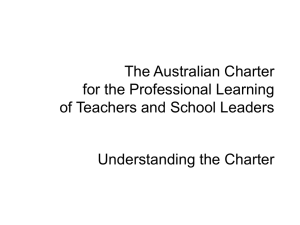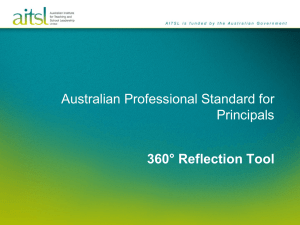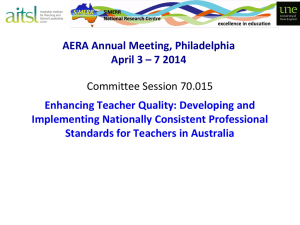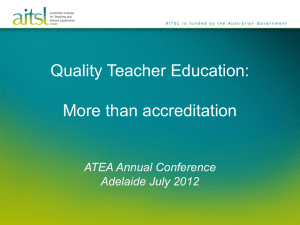National Professional Standards for Teachers
advertisement
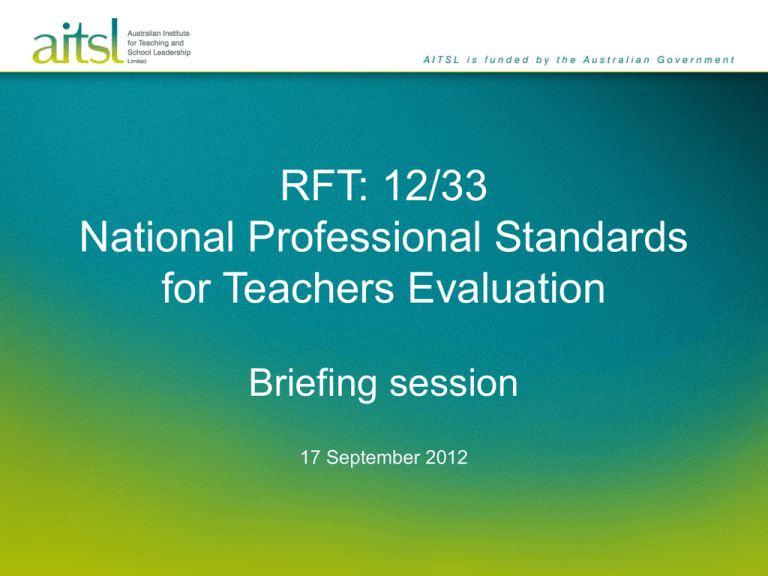
RFT: 12/33 National Professional Standards for Teachers Evaluation Briefing session 17 September 2012 > Welcome and introduction > Background – AITSL – National Professional Standards for Teachers > National Professional Standards for Teachers Evaluation Initiative requirements > Tender requirements > Procurement process > Questions and Answers Engage an organisation and/or consortium with demonstrated experience and expertise to design, develop and deliver a nationally focused, credible and innovative evaluation to determine the: • usefulness • effectiveness of implementation • impact of the National Professional Standards for Teachers to… • inform ongoing work to support effective and sustainable implementation and application of the Standards • demonstrate uptake and benefit of standards referenced approaches to students, teachers, schools and states and territory organisations and the broader community • enhance credibility and awareness of the Standards. AITSL works with the education community to: • set and maintain standards • lead and influence improvement • support and recognise quality We don’t... • act as a regulator • produce educational resources for use by children • employ teachers • formulate the national curriculum National Professional Standards for Teachers Background The National Professional Standards for Teachers is a public statement of what constitutes teacher quality. The Standards define the work of teachers and make explicit the elements of high-quality, effective teaching in 21st-century schools, which result in improved educational outcomes for students. Dual purpose: • improvement • accountability Career progression: • Graduate • Proficient • Highly Accomplished • Lead Graduate career stages of the NPST are the foundation for accreditation of Initial Teacher Education programs National approach endorsed by MCEEDYA in April 2011 AITSL works with relevant stakeholder to develop materials and processes to support he transition which commenced in 2012. Proficient career stages of the NPST provide the foundation for the approach to the registration and renewal of registration of teachers National approach endorsed by MCEEDYA in October 2011 AITSL is working with key stakeholders to develop a governance framework for implementation to enable commencement of the approach from 2012 The lead and highly accomplished career stages of the NPST form the foundation for the voluntary process of certification Approach was endorsed by SCSEEC in April 2012 AITSL is working with stakeholders to confirm transition and deeming arrangements, develop materials to support implementation in 2013 The NPST (together with the National Professional Standard for Principals and Professional Learning Charter) underpin the Australian Performance and Development Framework The Framework aims to: improve teacher effectiveness and student outcomes through the development of a culture in schools focused on continuous teacher performance appraisal, growth and improvement The Framework was endorsed by SCSEEC in August 2012 The NPST and the Australian Charter for the Professional Learning of Teachers and School Leaders communicate the role of professional learning in improving teacher and school leader practice The Charter was endorsed by SCSEEC in August 2012 AITSL works with stakeholders to develop and range of resources to support the implementation of the NPST • A launching place for Standards related content • Development of further supporting documentation for users and uses of the Standards • Additional information on corporate AITSL website www.aitsl.edu.au Project requirements > Determine the: – usefulness – effectiveness of implementation – impact of the National Professional Standards for Teachers. > Design, develop and deliver > Longitudinal and discrete modules > Commence: November 2012 Conclude: December 2015 > Organisation/consortia/subcontracting Stages Focus Indicative timeframe Phase 1: Development of evaluation plan and Evaluation design design & development November – December 2012 Phase 2 - 4: Evaluation and Implementation Conduct of evaluation in relevant phases including; longitudinal elements and discrete modules of evaluation, and analysis and synthesis and preparation of reports January 2012December 2015 Phase 5 Separately commissioned concluding January 2016 – synthesis of the evaluation to May 2016 contextualise findings in current policy context Research Questions Usefulness Strands of activity Accreditation (ITE) Structure Registration Certification Process Levels teacher/ school leaders School Jurisdiction National Performance & Development Professional Learning Community Support materials and resources Impact Focus Indicative timeframe Phase 1: Development of evaluation plan and Evaluation design design & development November – December 2012 Phase 2 - 4: Evaluation and Implementation January 2012December 2015 Conduct of evaluation in relevant phases including; longitudinal elements and discrete modules of evaluation, and analysis and synthesis and preparation of reports Separately commissioned concluding January 2016 – synthesis of the evaluation to May 2016 contextualise findings in current policy context > Research Framework – Research goals – Research questions – Methodologies – appropriate balance of: • • • • • Conventional and innovative modes, methods and data collection Qualitative and quantitative External and self-evaluation Formative and summative outcomes Potential to build capacity – Consider the context ie implementation timeframe & existing standards referenced approaches – Consider use of existing data and materials – Value for money > Shared responsibility of consultant and AITSL: – Consultant: communication directly related to design, development and delivery – AITSL: broader scale communication, including project outcomes > Evaluation Plan > Evaluation Implementation - for each phase – – – – sub-plan develop, deliver and monitor complete technical reports Progress reports Type Frequency Progress reports - verbal and written Monthly and quarterly Technical reports For specific modules Face-to- face presentation At least x 2 times per year Presentations to AITSL Board If and when required > AITSL Board > National Professional Standards for Teachers Evaluation project team > AITSL Internal Reference Group > Organisation and or consortium > Relevant high level experience and expertise > Project director > Sub-contractors Milestone Indicative timeframe Commencement of contract November 2012 Draft project plan - Consultant and AITSL meeting November 2012 Targeted testing of plan By early December 2012 Final project plan - presentation By mid December 2012 AITSL and consultant-led communication Mid December 2012/January 2013 Implementation of Evaluation – Phases 2-4 January 2013- December 2015 Consultant presentations to AITSL June and November 2013,14,15 Project completion December 2015. Tender requirements > High level evaluation plan: – – – – Evaluation framework – alignment between evaluation goals, research questions and methodologies Explanation of how the questions will be determined Identification and explanation of modes, methodologies and data collection for each phase and where appropriate each strand of activity Identification of the focus of each phase Demonstration of understanding of Australian education context and work of AITSL > Communications plan overview > Personnel > Risks and risk management strategy > Breakdown of costs > Referees > Additional information requested in Clause 5 Tender assessment > Two stage process: – Assessment of written tenders – Presentation by short-listed tenders Milestone Indicative date RFT closes Wednesday 10 October 2012 Stage 1 Assessment completed Late October 2012 Stage 2: Assessment completed By early November 2012 Offer to successful respondent By mid November 2012 > Contractual agreement scope subject to AITSL funding Questions and Answers Bronwyn Burr Manager: Policy and Programs research@aitsl.edu.au 07 3010 0111

